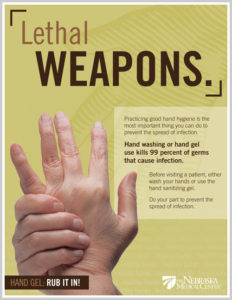
It is difficult to overstate the importance of healthcare associated infections (HAI). Approximately 4% of patients who enter hospitals in the United States develop an infection related to their hospital care. Although 4% may not sound like a big number, when you multiply 4% by the tens of millions of admissions to U.S. hospitals, it equates to 1-2 million infections per year resulting in billions of dollars of excess cost and approximately 100,000 deaths. This is one of the leading causes of death in the United States!
The Infection Prevention team at Nebraska Medicine coordinates a multi-faceted approach to minimize a patient’s risk for HAI.
- First, we stress standard infection control measures- hand hygiene is the cornerstone, and our surveillance program, with over 118,000 opportunities for hand hygiene observed, documents overall compliance of ~90% (although we are not satisfied with this level of hand hygiene and our target is 100%, it is much better than compliance cited in most of the published literature).
- We also stress appropriate isolation precautions for patients with some types of infections due to antibiotic-resistant pathogens.
- We know a clean environment is important and we use an invisible UV-tagged marking gel to ensure that our housekeepers are thorough in their cleaning and disinfection of patient rooms and the healthcare environment- they do a terrific job and their numbers prove it! In addition, for rooms potentially contaminated with antibiotic-resistant pathogens or environmentally hardy spores, we disinfect the rooms with an UV-irradiation robot!
- Furthermore, in our fight against pathogen acquisition and transmission, all of our patients are bathed daily with an antiseptic soap called chlorhexidine. This intervention has been proven to prevent bloodstream infections and stop the transmission of antibiotic-resistant pathogens.
- Because medical devices such as urinary catheters and intravenous lines can put patients at risk of infection, we stress careful insertion and care procedures, and protocols are in place to remove devices as soon as they are no longer needed. Intravenous catheters are further protected with chlorhexidine-impregnated dressings and the hubs are covered with an alcohol-containing passive port protector.
- Another robust program to prevent infections is our respiratory etiquette program and our yearly healthcare worker influenza vaccination campaign. We are proud to note that over 90% of our bedside providers are vaccinated each year.
These are just some of the efforts that are in effect, largely “behind the scenes” to keep our patients safe from infection. We recognize that infection prevention is a team sport and we are all part of the team.
– Content from Dr. Mark Rupp, Professor and Chief, Division of Infectious Diseases; Medical Director, Department of Infection Control & Epidemiology
1 comment